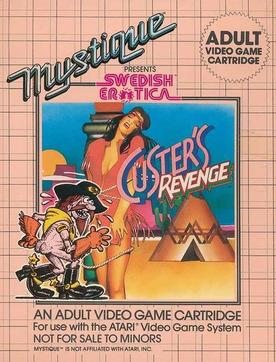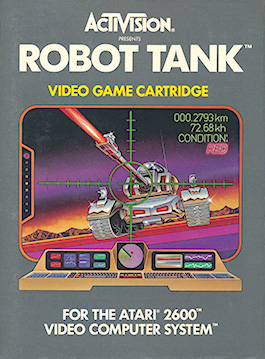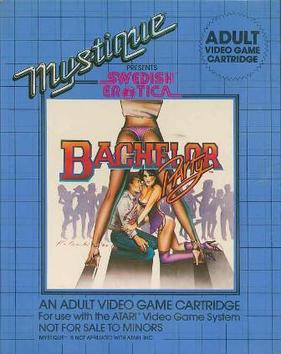
The Atari 2600 is a home video game console developed and produced by Atari, Inc. Released in September 1977 as the Atari Video Computer System, it popularized microprocessor-based hardware and games stored on swappable ROM cartridges, a format first used with the Fairchild Channel F in 1976. The VCS was bundled with two joystick controllers, a conjoined pair of paddle controllers, and a game cartridge—initially Combat and later Pac-Man. Sears sold the system as the Tele-Games Video Arcade. Atari rebranded the VCS as the Atari 2600 in November 1982 alongside the release of the Atari 5200.

ColecoVision is a second-generation home video-game console developed by Coleco and launched in North America in August 1982. It was released a year later in Europe by CBS Electronics as the CBS ColecoVision.
The video game crash of 1983 was a large-scale recession in the video game industry that occurred from 1983 to 1985, primarily in the United States. The crash was attributed to several factors, including market saturation in the number of video game consoles and available games, many of which were of poor quality. Waning interest in console games in favor of personal computers also played a role. Home video game revenue peaked at around $3.2 billion in 1983, then fell to around $100 million by 1985. The crash abruptly ended what is retrospectively considered the second generation of console video gaming in North America. To a lesser extent, the arcade video game market also weakened as the golden age of arcade video games came to an end.

E.T. the Extra-Terrestrial is a 1982 adventure video game developed and published by Atari, Inc. for the Atari 2600 and based on the film of the same name. The game's objective is to guide the eponymous character through various screens to collect three pieces of an interplanetary telephone that will allow him to contact his home planet.

Kaboom! is an action video game published in 1981 by Activision for the Atari 2600. The gameplay was based on the Atari arcade game Avalanche (1978), with the game now involving a Mad Bomber who drops bombs instead of falling rocks. Kaboom! was programmed by Larry Kaplan with David Crane coding the graphics for the buckets and Mad Bomber. It was the last game designed by Kaplan for Activision, who left the company shortly after the release of the game. The game was later ported by Paul Wilson for the Atari 5200 system.

Custer's Revenge is an adult action game published by American Multiple Industries for the Atari 2600, first released in November 1982. The game gained notoriety owing to its goal of raping a Native American woman who is tied to a post.

Atari Games Corporation, known as Midway Games West Inc. after 1999, was an American producer of arcade games. It was formed in 1985 when the coin-operated arcade video game division of Atari, Inc. was transferred by Warner Communications to a joint venture with Namco. It was one of several successor companies to use the name Atari. The company developed and published games for arcades and across consumer gaming consoles such as the Commodore 16, Commodore 64, Game Boy, Nintendo Entertainment System (NES) and other platforms using the Tengen label. Some of the games Atari had developed include Tetris, Road Runner, RoadBlasters and Primal Rage. After Time Warner reassumed full ownership in 1994, the company was sold to WMS Industries in 1996, and became part of Midway Games when that company was spun-off by WMS in 1998. It ceased operations in 2003 and its former assets were sold back to Warner Bros. Interactive Entertainment in 2009 following Midway's bankruptcy.
A sports video game is a video game that simulates the practice of sports. Most sports have been recreated with video games, including team sports, track and field, extreme sports, and combat sports. Some games emphasize playing the sport, whilst others emphasize strategy and sport management. Some, such as Need for Speed, Arch Rivals and Punch-Out!!, satirize the sport for comic effect. This genre has been popular throughout the history of video games and is competitive, just like real-world sports. A number of game series feature the names and characteristics of real teams and players, and are updated annually to reflect real-world changes. The sports genre is one of the oldest genres in gaming history.

Qix is a 1981 puzzle video game developed by husband and wife team Randy and Sandy Pfeiffer and published in arcades by Taito America. Qix is one of a handful of games made by Taito's American division. At the start of each level, the playing field is a large, empty rectangle, containing the Qix, an abstract stick-like entity that performs graceful but unpredictable motions within the confines of the rectangle. The objective is to draw lines that close off parts of the rectangle to fill in a set amount of the playfield.
1982 was the peak year for the golden age of arcade video games as well as the second generation of video game consoles. Many games were released that would spawn franchises, or at least sequels, including Dig Dug, Pole Position, Mr. Do!, Zaxxon, Q*bert, Time Pilot and Pitfall! The year's highest-grossing video game was Namco's arcade game Pac-Man, for the third year in a row, while the year's best-selling home system was the Atari 2600. Additional video game consoles added to a crowded market, notably the ColecoVision and Atari 5200. Troubles at Atari late in the year triggered the video game crash of 1983.
1976 had new titles such as Road Race, Night Driver, Heavyweight Champ, Sea Wolf and Breakout. The year's highest-grossing arcade games were Namco's F-1 in Japan and Midway's Sea Wolf in the United States.

Robot Tank is a first-person shoot 'em up written by Alan Miller for the Atari 2600 and published by Activision in 1983. It is similar in design to Atari, Inc.'s Battlezone tank combat arcade video game and more so to its 2600 port. Robot Tank adds different systems which can individually be damaged—instead of the vehicle always exploding upon being shot—and weather effects.
Video games featuring sexual content has been found since the early days of the industry and can be found on most platforms and can be of any video game genre.
PlayAround was formed by Joel H. Martin, co-founder of American Multiple Industries, the first Atari 2600 adult video game company. PlayAround purchased the rights to American Multiple Industries's titles and released them as "double-enders" - extra-long cartridges that had a different game on each end. PlayAround released additional titles unique from those picked up from American Multiple Industries, and made female versions of several of their games to try to tap into another market, which didn't work very well. While the games' themes may be considered adult, the graphics are quite blocky and generally poor enough that it takes quite an imagination to see them as anything more than a novelty.

Bachelor Party is a pornographic video game for the Atari 2600 by American Multiple Industries in 1982.

Beat 'Em and Eat 'Em is a pornographic video game for the Atari 2600 by American Multiple Industries in 1982. Players control two nude women; the goal is to catch semen in their mouths, which is falling from a masturbating man on a rooftop, without missing. Its gameplay has been compared to the Atari game Kaboom!. There is also a gender-reversed version of the game titled Philly Flasher that features identical gameplay. Beat 'Em & Eat 'Em has received negative reviews since its release and is an oft-cited example of pornographic Atari 2600 games.
A side-scrolling video game is a game viewed from a side-view camera angle where the screen follows the player as they move left or right. The jump from single-screen or flip-screen graphics to scrolling graphics during the golden age of arcade games was a pivotal leap in game design, comparable to the move to 3D graphics during the fifth generation.

M Network was a video game division of Mattel that, in the 1980s, produced games in cartridge format for the Atari 2600 video game system.

Z-Tack is a shoot 'em up for the Atari 2600 from Asia-based developer Onbase Co. and published under its Bomb label in 1983. The player controls an alien ship flying above a city with a goal of destroying bases nestled in the buildings. There are six different city-landscapes. The game received mixed reviews from critics and was described as an inverted version of Imagic's Atlantis.

Atari, Inc. v. North American Philips Consumer Electronics Corp., 672 F.2d 607, is one of the first legal cases applying copyright law to video games, barring sales of the game K.C. Munchkin! for its similarities to Pac-Man. Atari had licensed the commercially successful arcade game Pac-Man from Namco and Midway, to produce a version for their Atari 2600 console. Around the same time, Philips created Munchkin as a similar maze-chase game, leading Atari to sue them for copyright infringement.












